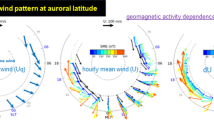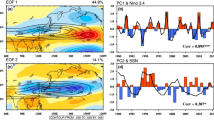Abstract
In this work we study the temporal and latitudinal variations of the solar wind mass flux at 1 AU derived from SOHO/SWAN data on backscattered solar Lyman-\(\alpha \) radiation in 1996 – 2018. Previously Katushkina et al. (J. Geophys. Res. 118, 2800, 2013) have shown that the latitudinal profiles of the solar wind mass flux during the solar maximum 2001 – 2003 have two separate peaks at middle heliolatitudes. In this work we provide the data for the last solar maximum in 2014 – 2016 and show that the specific latitudinal distribution appears again. However, in 2014 – 2016 the two peaks are less separated and sometimes merged to one peak. For several years we have performed a comparison of SWAN observations with the results of the WSA-Enlil model, which is a coupled 3D time-dependent model of the solar wind propagation from the solar corona to the heliosphere. It is shown that the WSA-Enlil model confirms qualitatively the latitudinal distribution of the solar wind found from the SWAN data, although there are some quantitative differences. Physical reasons for the formation of this latitudinal structure at the solar maxima are discussed. Further investigation is needed and could provide new links between the solar corona and the heliospheric environment.







Similar content being viewed by others
References
Arge, C.N., Pizzo, V.J.: 2000, J. Geophys. Res. 105, 10465. DOI .
Arge, C.N., Odstrcil, D., Pizzo, V.J., Mayer, L.R.: 2003, Solar Wind Ten 679, 190. DOI .
Bemporad, A.: 2017, Astrophys. J. 846, 86. DOI .
Bertaux, J.L., Kyrölä, E., Quémerais, E., Pellinen, R., Lallement, R., Schmidt, W., Berthé, M., Dimarellis, E., Goutail, J.P., Taulemesse, C., Bernard, C., Leppelmeier, G., Summanen, T., Hannula, H., Huomo, H., Kehlä, V., Korpela, S., Leppälä, K., Strömmer, E., Torsti, J., Viherkanto, K., Hochedez, J.F., Chretiennot, G., Peyroux, R., Holzer, T. (eds.): 1995, Solar Phys. 162, 403. DOI .
Bruno, R., Villante, U., Bavassano, B., Schwenn, R., Mariani, F.: 1986, Solar Phys. 104, 431. DOI .
Ebert, R.W., McComas, D.J., Elliott, H.A., Forsyth, R.J., Gosling, J.T.: 2009, J. Geophys. Res. 114, A01109. DOI .
Gringauz, K.I., Bezrokikh, V.V., Ozerov, V.D., Rybchinskii, R.E.: 1960, Sov. Phys. Dokl. 5, 361. ADS .
Hundhausen, A.J., Bame, S.J., Asbridge, J.R., Sydoriak, S.J.: 1970, J. Geophys. Res. 75, 4643. DOI .
Izmodenov, V.V., Alexashov, D.B.: 2015, Astrophys. J. Suppl. Ser. 220, 32. DOI .
Izmodenov, V.V., Katushkina, O.A., Quémerais, E., Bzowski, M.: 2013, Cross-Calibration of Far UV Spectra of Solar System Objects and the Heliosphere 7. DOI .
Jian, L.K., MacNeice, P., Taktakishvili, A., Odstrcil, D., Jackson, B., Yu, H.-S., Riley, P., Sokolov, I.: 2015, Space Weather 13, 316. DOI .
Jian, L.K., MacNeice, P., Mays, M.L., Taktakishvili, A., Odstrcil, D., Jackson, B., Yu, H.-S., Riley, P., Sokolov, I.: 2016, Space Weather 14, 592. DOI .
Joselyn, J.A., Holzer, T.E.: 1975, J. Geophys. Res. 80, 903. DOI .
Katushkina, O.A., Izmodenov, V.V., Quemerais, E., Sokół, J.M.: 2013, J. Geophys. Res. 118, 2800. DOI .
Katushkina, O.A., Izmodenov, V.V., Alexashov, D.B., Schwadron, N.A., McComas, D.J.: 2015, Astrophys. J. Suppl. Ser. 220, 33. DOI .
King, J.H., Papitashvili, N.E.: 2005, J. Geophys. Res. 110, A02104. DOI .
Kramar, M., Jones, S., Davila, J., Inhester, B., Mierla, M.: 2009, Solar Phys. 259, 109. DOI .
Kramar, M., Airapetian, V., Lin, H.: 2016, Front. Astron. Space Sci. 3, 25. DOI .
Lallement, R., Bertaux, J.L., Kurt, V.G.: 1985a, J. Geophys. Res. 90, 1413. DOI .
Lallement, R., Bertaux, J.L., Dalaudier, F.: 1985b, Astron. Astrophys. 150, 21. ADS .
Lallement, R., Quémerais, E., Koutroumpa, D., Bertaux, J.-L., Ferron, S., Schmidt, W., Lamy, P.: 2010, Twelfth International Solar Wind Conference 1216, 555. DOI .
Lamy, P., Barlyaeva, T., Llebaria, A., Floyd, O.: 2014, J. Geophys. Res. 119, 47. DOI .
Lamy, P., Floyd, O., Quémerais, E., Boclet, B., Ferron, S.: 2017, J. Geophys. Res. 122, 50. DOI .
Le Chat, G., Issautier, K., Meyer-Vernet, N.: 2012, Solar Phys. 279, 197. DOI .
Lindsay, B.G., Stebbings, R.F.: 2005, J. Geophys. Res. 110, A12213. DOI .
Lowder, C., Qiu, J., Leamon, R.: 2017, Solar Phys. 292, 18. DOI .
McComas, D.J., Barraclough, B.L., Funsten, H.O., Gosling, J.T., Santiago-Muñoz, E., Skoug, R.M., Goldstein, B.E., Neugebauer, M., Riley, P., Balogh, A.: 2000, J. Geophys. Res. 105, 10419. DOI .
McComas, D.J., Elliott, H.A., Gosling, J.T., Reisenfeld, D.B., Skoug, R.M., Goldstein, B.E., Neugebauer, M., Balogh, A.: 2002, Geophys. Res. Lett. 29, 1290. DOI .
McComas, D.J.: 2003, Solar Wind Ten 679, 33. DOI .
McComas, D.J., Elliott, H.A., Gosling, J.T., Skoug, R.M.: 2006, Geophys. Res. Lett. 33, L09102. DOI .
McComas, D.J., Ebert, R.W., Elliott, H.A., Goldstein, B.E., Gosling, J.T., Schwadron, N.A., Skoug, R.M.: 2008, Geophys. Res. Lett. 35, L18103. DOI .
McComas, D.J., Angold, N., Elliott, H.A., Livadiotis, G., Schwadron, N.A., Skoug, R.M., Smith, C.W.: 2013, Astrophys. J. 779, 2. DOI .
McIntosh, S.W., Leamon, R.J., Krista, L.D., Title, A.M., Hudson, H.S., Riley, P., Harder, J.W., Kopp, G., Snow, M., Woods, T.N., Kasper, J.C., Stevens, M.L., Ulrich, R.K.: 2015, Nat. Commun. 6, 6491. DOI .
Meier, R.R.: 1977, Astron. Astrophys. 55, 211. ADS .
Neugebauer, M., Snyder, C.W.: 1962, Science 138, 1095. DOI .
Neugebauer, M., Snyder, C.W.: 1966, J. Geophys. Res. 71, 4469. DOI .
Odstrcil, D.: 2003, Adv. Space Res. 32, 497. DOI .
Parker, E.N.: 1958, Astrophys. J. 128, 664. DOI .
Pizzo, V., Millward, G., Parsons, A., Biesecker, D., Hill, S., Odstrcil, D.: 2011, Space Weather 9, S03004. DOI .
Quémerais, E., Izmodenov, V.: 2002, Astron. Astrophys. 396, 269. DOI .
Quémerais, E., Lamy, P.: 2002, Astron. Astrophys. 393, 295. DOI .
Quémerais, E., Lallement, R., Ferron, S., Koutroumpa, D., Bertaux, J.-L., KyröLä, E., Schmidt, W.: 2006, J. Geophys. Res. 111, A09114. DOI .
Schwenn, R.: 2006, Space Sci. Rev. 124, 51. DOI .
Steinitz, R.: 1983, Solar Phys. 83, 379. DOI .
Steinitz, R., Eyni, M.: 1980, Astrophys. J. 241, 417. DOI .
Tokumaru, M., Kojima, M., Fujiki, K.: 2012, J. Geophys. Res. 117, A06108. DOI .
Wu, F.M., Judge, D.L.: 1979, Astrophys. J. 231, 594. DOI .
Acknowledgements
Numerical modeling of the backscattered Lyman-\(\alpha \) intensity maps is supported by Russian Foundation for Basic Research (RFBR) (grant 16-52-16008-CNRS-a). Calculations of the interstellar hydrogen distribution in the heliosphere is carried out by the research Program (“Goszadanie”) “Plasma” of Space Research Institute Russian Academy of Sciences. Analysis of the solar wind mass flux is supported by the Foundation for the Advancement of Theoretical Physics and Mathematics “BASIS”.
SOHO is a mission of international cooperation between ESA and NASA. SWAN activities in France are funded by CNES through the SHM program. The SWAN inversion simulations were performed at the HPCaVe at UPMC-Sorbonne Université.
LKJ is supported by NASA’s Living with a Star program. WSA-Enlil simulation results have been provided by the CCMC at NASA/GSFC through their public Runs on Request system. The WSA-Enlil model was developed by Nick Arge and Dusan Odstrcil. We thank Dusan Odstrcil, Peter MacNeice and Leila Mays for helpful discussion and anonymous reviewer for very useful suggestions that helped to improve this paper.
VI and LKJ are grateful for the support from the International Space Science Institute in Bern in the framework of the team “The Physics of the Very Local Interstellar Medium”.
Author information
Authors and Affiliations
Corresponding author
Ethics declarations
Disclosure of potential conflicts of interest
The authors declare that they have no conflicts of interest.
Additional information
Publisher’s Note
Springer Nature remains neutral with regard to jurisdictional claims in published maps and institutional affiliations.
This article belongs to the Topical Collection:
Solar Wind at the Dawn of the Parker Solar Probe and Solar Orbiter Era
Guest Editors: Giovanni Lapenta and Andrei Zhukov
Rights and permissions
About this article
Cite this article
Katushkina, O., Izmodenov, V., Koutroumpa, D. et al. Unexpected Behavior of the Solar Wind Mass Flux During Solar Maxima: Two Peaks at Middle Heliolatitudes. Sol Phys 294, 17 (2019). https://doi.org/10.1007/s11207-018-1391-5
Received:
Accepted:
Published:
DOI: https://doi.org/10.1007/s11207-018-1391-5




